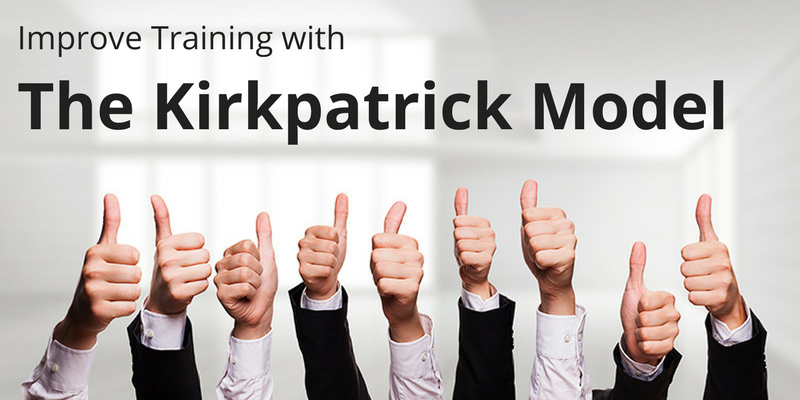
This is part three of our Kirkpatrick Model series, by Hannah Brenner, in which we explore how to measure the results of training evaluation and determine desired behaviors. If you haven’t yet, check out part one here and part two here.
So far in this series, we have defined Kirkpatrick’s four levels of training evaluation, discussed the importance of planning backwards, gone into detail about Level 4: Results, and posed challenge questions to some common objections.
By now, you should know your big goal and the leading indicators that will guide you. Once you have this information, the next step is to determine what behaviors are needed to ensure you get there. This is level 3.
Level 3: Behavior is defined as, “the degree to which participants apply what they learned during training when they are back on the job.” This is the most important level for trainers as it’s where training is put into action. This is also one of the hardest for trainers to see through, as it requires them to go beyond instruction and put various systems of reinforcement in place. But before I get ahead of myself, let’s talk about these behaviors.
Critical Behaviors
The first thing to do is define your critical behaviors. It is important to note that I said critical behaviors, so you need to know the difference between a critical behavior and just a behavior.
Let’s go back to our road trip. To reach each of your mile markers or stopping points successfully, you must do a few things to prepare for the trip and as you continue your route.
For instance, the night before your trip you need to sleep. This will ensure you don’t fall asleep at the wheel or drive groggy, which is extremely dangerous. You also need to inspect your car and make sure it can make the trip: check your oil, tire pressure, etc. And most importantly, you need to put gas in your car. You aren’t going to get very far without it! As you continue your trip, you need to make rest stops, eat meals, and continue to fill your tank with gas.
These are all critical behaviors – essential to reaching your destination safely.
Some other things you might do may include updating your music playlist, cleaning off the seats and floorboards, and stocking your car with snacks and (if you have children) games to play. These are all great for planning, but they are not essential to the trip. This is the difference between a critical behavior and a behavior.
“If a behavior is termed critical but it is acceptable to not perform it regularly, then it is not truly critical.”
When choosing your critical behaviors, keep in mind that less is more. It is unrealistic to have 30 items that are deemed “critical” for someone to follow. However, if you choose 5 behaviors that must be done, most employees can remember to perform them.
Additionally, these behaviors need to be observable. You must be able to rate them or check them off a list. This is the only way to evaluate if the behaviors are truly taking place post-training.
Competencies
This bring me to the idea of competencies. Competency-based training is a hot trend right now; clients talk to me about them daily. I see how it can be very tempting to pick a handful of competencies for each job role and start planning from there.
The problem is, there’s no way to measure a competency. How do you measure someone’s conflict management or active listening?
You can’t, it’s all subjective. But you can measure the critical behaviors of summarizing the problem, asking clarifying questions, and giving written feedback (all of which are components of these competencies).
Until you know the expected action/behavior, you will not know what to teach. If you start with the behavior, you can then support it with a competency.
Ongoing Support
To ensure these behaviors are occurring, systems of accountability need to be put in place before the training begins. This means you need management buy-in from the start. Ongoing reinforcement and support cannot and will not be successful without managers on board.
Once you have this support, it is time to put together your accountability system. This would include monitoring, reinforcing, encouraging and rewarding participants. Each of these four areas is an essential component of your support system. Participants need to be encouraged and rewarded for putting their learning into action and have reinforcement when they are not. The easiest way to do this is with monitoring.
The good news is, none of this needs to be time consuming. There are quick ways to address each of these areas in conjunction with each other, while knowing what is realistic for your organization.
For example, you can easily reinforce your online training with BizLibrary’s reinforcement tool BoosterLearn. This automatically sends reinforcement boosters in the days and weeks following training to improve learning retention and offset the forgetting curve. Trainers can then report on this data and reward or follow-up with participants when needed.
Once you have identified these critical behaviors, supporting competencies (if desired), and how you will continuously support participants post training, it is finally time to start determining what information needs to be learned during training. We will address this next week when discussing Level 2: Learning.
Read more: Using the Kirkpatrick Model to Evaluate Training: Part Four
For more information on determining desired behavioral outcomes – please visit the Kirkpatrick Partners website at www.kirkpatrickpartners.com or check out the book Four Levels of Training Evaluation.
Learn more about how post-training reinforcement creates the behavior changes you’re looking for – view our free webinar presented by cognitive neuroscience expert, Dr. Art Kohn.
Hannah Brenner is a Client Success Consultant with BizLibrary. She discusses training strategies and works with her clients to constantly improve their training program and see a positive return on investment.

